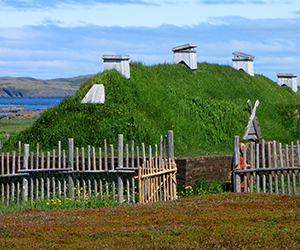CANADA HISTORY
Gitxsan

The Gitxsan people, also known as the Gitksan, are a First Nations people who have lived in what is now known as the Skeena River region in British Columbia, Canada, for thousands of years prior to contact with Europeans. The Gitxsan have a rich and diverse cultural heritage, which includes a complex social, political, and economic system based on the ownership of land and resources.
Before contact with Europeans, the Gitxsan were a matrilineal society, which means that descent and inheritance were traced through the mother's line. The Gitxsan had a system of hereditary chiefs, each with specific territories and responsibilities. The Gitxsan also had a complex network of trade and inter-village alliances, which were maintained through gift-giving, potlatch ceremonies, and other social and economic interactions.
The Gitxsan were also known for their rich artistic traditions, including storytelling, weaving, wood carving, and other forms of cultural expression. These artistic traditions were closely tied to the Gitxsan's spiritual beliefs and worldview, which included a complex cosmology and a deep respect for the natural world.
Overall, the Gitxsan culture was deeply rooted in the land and its resources, and the Gitxsan people had a strong connection to their territories, which they viewed as their ancestral home. The Gitxsan maintained their cultural practices and traditions despite colonization and ongoing efforts by the Canadian government to assimilate Indigenous peoples.
The Gitxsan people had a rich spiritual tradition that was closely connected to their relationship with the land and the natural world. They believed in a complex cosmology that included a variety of spirits and supernatural beings, and their spiritual beliefs were interwoven with their daily lives.
The Gitxsan believed in a Supreme Being, sometimes referred to as "Sgitxsan", who was responsible for the creation of the world and all of its inhabitants. They also believed in a variety of lesser spirits, including nature spirits, ancestor spirits, and the spirits of the animals that they hunted and fished.
The Gitxsan practiced a form of animism, which means that they believed that everything in the natural world, including animals, plants, and natural features, had spiritual power and could interact with human beings. They also believed in the power of dreams, visions, and other supernatural experiences, and these experiences were often considered to be significant spiritual events that could influence the course of a person's life.
In addition to these beliefs, the Gitxsan also held potlatch ceremonies, which were important social and spiritual events that served as a way to strengthen relationships and redistribute wealth within the community. During these ceremonies, gifts were exchanged, stories were told, and spiritual songs were sung.
Overall, the Gitxsan's religious beliefs were deeply rooted in their connection to the land and the natural world, and their spiritual practices and traditions played a central role in their daily lives and cultural identity.
The Gitxsan people had complex relationships with other indigenous peoples in the region, which were shaped by a combination of trade, intermarriage, and political alliances.
The Gitxsan maintained trade networks with neighboring indigenous peoples, exchanging goods such as furs, food, and other resources. They also intermarried with other indigenous groups, which helped to strengthen social and economic ties.
In some cases, the Gitxsan formed political alliances with neighboring groups for mutual benefit. For example, they might join forces to defend their territories against outside threats or to negotiate with European colonizers.
However, the relationships between the Gitxsan and other indigenous groups were not always peaceful. There were instances of conflict, particularly over territory and resources, and some neighboring groups were considered to be traditional enemies of the Gitxsan.
The Gitxsan people were primarily subsistence hunters, fishers, and gatherers, and their food and materials were sourced from the surrounding forests, rivers, and coastal waters.
The Gitxsan relied heavily on salmon, which was a key source of protein and a staple food. They also hunted a variety of other fish and wildlife, including eulachon (a type of smelt), halibut, and deer, as well as gathering wild plants such as berries and roots.
In addition to food, the Gitxsan also relied on the natural resources of their territories for other materials. They used cedar and other types of wood for building houses, making canoes, and crafting a variety of other tools and items. They also made clothing and blankets from animal hides and woven cedar bark, and they created jewelry and other decorative items from materials such as shell, stone, and bone.
Overall, the Gitxsan people had a deep knowledge of the natural resources in their territories, and they relied on these resources for their sustenance and well-being. Their relationship with the land and its resources was integral to their culture and way of life.
These are some of the key events and dates in Gitxsan history:
Pre-contact: The Gitxsan people have lived in the Skeena River region of British Columbia for thousands of years prior to European contact. During this time, they developed a complex and sophisticated society based on the ownership of land and resources, matrilineal descent, and a rich spiritual tradition.
First contact with Europeans: The first recorded contact between the Gitxsan and Europeans took place in the late 1700s, when explorers and fur traders from Europe began to arrive in the region. This contact brought significant changes to the Gitxsan way of life, including the introduction of new diseases, new forms of trade and commerce, and the gradual loss of their territories and resources.
The Hudson's Bay Company: The Hudson's Bay Company was a powerful fur trading company that had a significant impact on the Gitxsan people during the late 1700s and early 1800s. The company established trading posts in the region, and the Gitxsan were forced to compete with other indigenous groups for access to trade goods and resources.
Treaty negotiations: The Gitxsan, along with other indigenous groups in the region, began negotiating treaties with the Canadian government in the late 1800s. These negotiations were often contentious and resulted in the loss of much of the Gitxsan's traditional territories and resources.
Modern era: The Gitxsan continue to maintain their cultural traditions and way of life in the modern era. They have been involved in ongoing struggles to protect their rights and reclaim their territories, and they continue to be an important and vibrant part of the indigenous community in British Columbia.

Cite Article : www.canadahistory.com/sections/documents




